technical specifications FIAT IDEA 2009 1.G Owners Manual
[x] Cancel search | Manufacturer: FIAT, Model Year: 2009, Model line: IDEA, Model: FIAT IDEA 2009 1.GPages: 210, PDF Size: 3.62 MB
Page 175 of 210
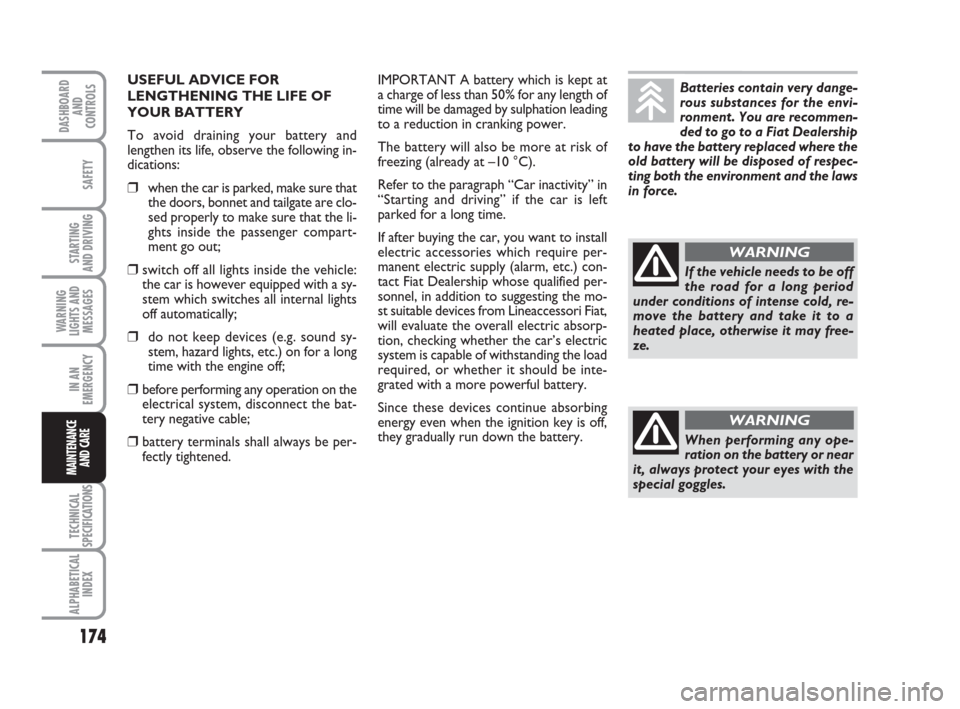
174
STARTING
AND DRIVING
IN AN
EMERGENCY
TECHNICAL
SPECIFICATIONS
ALPHABETICAL
INDEX
DASHBOARD
AND
CONTROLS
SAFETY
WARNING
LIGHTS AND
MESSAGES
MAINTENANCE
AND CARE
IMPORTANT A battery which is kept at
a charge of less than 50% for any length of
time will be damaged by sulphation leading
to a reduction in cranking power.
The battery will also be more at risk of
freezing (already at –10 °C).
Refer to the paragraph “Car inactivity” in
“Starting and driving” if the car is left
parked for a long time.
If after buying the car, you want to install
electric accessories which require per-
manent electric supply (alarm, etc.) con-
tact Fiat Dealership whose qualified per-
sonnel, in addition to suggesting the mo-
st suitable devices from Lineaccessori Fiat,
will evaluate the overall electric absorp-
tion, checking whether the car’s electric
system is capable of withstanding the load
required, or whether it should be inte-
grated with a more powerful battery.
Since these devices continue absorbing
energy even when the ignition key is off,
they gradually run down the battery. USEFUL ADVICE FOR
LENGTHENING THE LIFE OF
YOUR BATTERY
To avoid draining your battery and
lengthen its life, observe the following in-
dications:
❒when the car is parked, make sure that
the doors, bonnet and tailgate are clo-
sed properly to make sure that the li-
ghts inside the passenger compart-
ment go out;
❒switch off all lights inside the vehicle:
the car is however equipped with a sy-
stem which switches all internal lights
off automatically;
❒do not keep devices (e.g. sound sy-
stem, hazard lights, etc.) on for a long
time with the engine off;
❒before performing any operation on the
electrical system, disconnect the bat-
tery negative cable;
❒battery terminals shall always be per-
fectly tightened.Batteries contain very dange-
rous substances for the envi-
ronment. You are recommen-
ded to go to a Fiat Dealership
to have the battery replaced where the
old battery will be disposed of respec-
ting both the environment and the laws
in force.
If the vehicle needs to be off
the road for a long period
under conditions of intense cold, re-
move the battery and take it to a
heated place, otherwise it may free-
ze.
WARNING
When performing any ope-
ration on the battery or near
it, always protect your eyes with the
special goggles.
WARNING
Page 176 of 210
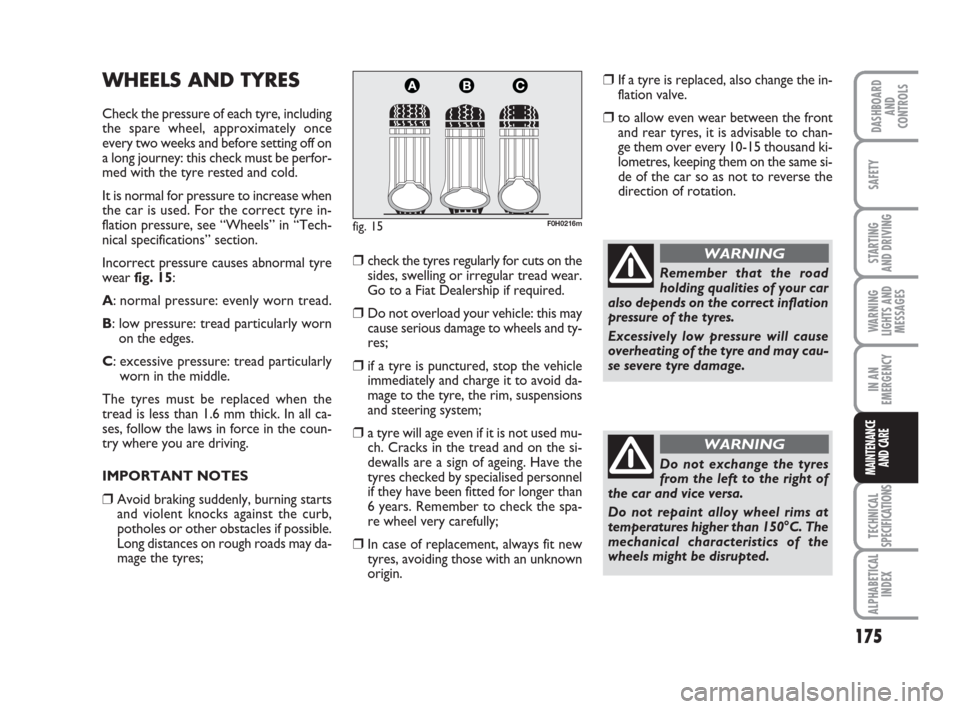
175
STARTING
AND DRIVING
IN AN
EMERGENCY
TECHNICAL
SPECIFICATIONS
ALPHABETICAL
INDEX
DASHBOARD
AND
CONTROLS
SAFETY
WARNING
LIGHTS AND
MESSAGES
MAINTENANCE
AND CARE
WHEELS AND TYRES
Check the pressure of each tyre, including
the spare wheel, approximately once
every two weeks and before setting off on
a long journey: this check must be perfor-
med with the tyre rested and cold.
It is normal for pressure to increase when
the car is used. For the correct tyre in-
flation pressure, see “Wheels” in “Tech-
nical specifications” section.
Incorrect pressure causes abnormal tyre
wearfig. 15:
A: normal pressure: evenly worn tread.
B: low pressure: tread particularly worn
on the edges.
C: excessive pressure: tread particularly
worn in the middle.
The tyres must be replaced when the
tread is less than 1.6 mm thick. In all ca-
ses, follow the laws in force in the coun-
try where you are driving.
IMPORTANT NOTES
❒Avoid braking suddenly, burning starts
and violent knocks against the curb,
potholes or other obstacles if possible.
Long distances on rough roads may da-
mage the tyres;
❒check the tyres regularly for cuts on the
sides, swelling or irregular tread wear.
Go to a Fiat Dealership if required.
❒Do not overload your vehicle: this may
cause serious damage to wheels and ty-
res;
❒if a tyre is punctured, stop the vehicle
immediately and charge it to avoid da-
mage to the tyre, the rim, suspensions
and steering system;
❒a tyre will age even if it is not used mu-
ch. Cracks in the tread and on the si-
dewalls are a sign of ageing. Have the
tyres checked by specialised personnel
if they have been fitted for longer than
6 years. Remember to check the spa-
re wheel very carefully;
❒In case of replacement, always fit new
tyres, avoiding those with an unknown
origin.
fig. 15F0H0216m
Remember that the road
holding qualities of your car
also depends on the correct inflation
pressure of the tyres.
Excessively low pressure will cause
overheating of the tyre and may cau-
se severe tyre damage.
WARNING
Do not exchange the tyres
from the left to the right of
the car and vice versa.
Do not repaint alloy wheel rims at
temperatures higher than 150°C. The
mechanical characteristics of the
wheels might be disrupted.
WARNING
❒If a tyre is replaced, also change the in-
flation valve.
❒to allow even wear between the front
and rear tyres, it is advisable to chan-
ge them over every 10-15 thousand ki-
lometres, keeping them on the same si-
de of the car so as not to reverse the
direction of rotation.
Page 177 of 210
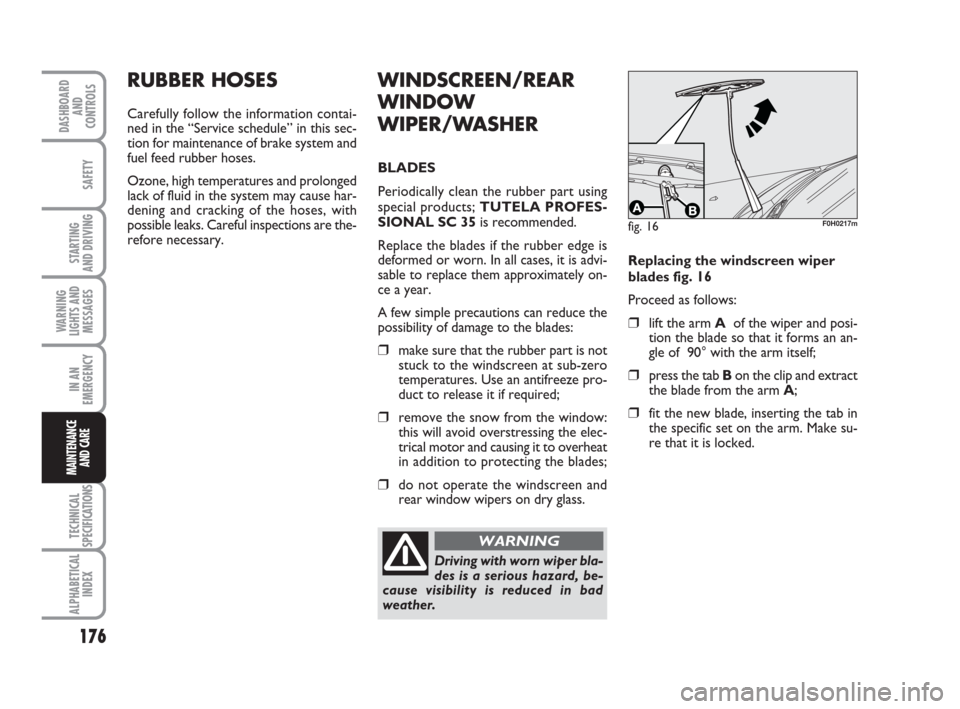
176
STARTING
AND DRIVING
IN AN
EMERGENCY
TECHNICAL
SPECIFICATIONS
ALPHABETICAL
INDEX
DASHBOARD
AND
CONTROLS
SAFETY
WARNING
LIGHTS AND
MESSAGES
MAINTENANCE
AND CARE
RUBBER HOSES
Carefully follow the information contai-
ned in the “Service schedule” in this sec-
tion for maintenance of brake system and
fuel feed rubber hoses.
Ozone, high temperatures and prolonged
lack of fluid in the system may cause har-
dening and cracking of the hoses, with
possible leaks. Careful inspections are the-
refore necessary.
WINDSCREEN/REAR
WINDOW
WIPER/WASHER
BLADES
Periodically clean the rubber part using
special products; TUTELA PROFES-
SIONAL SC 35is recommended.
Replace the blades if the rubber edge is
deformed or worn. In all cases, it is advi-
sable to replace them approximately on-
ce a year.
A few simple precautions can reduce the
possibility of damage to the blades:
❒make sure that the rubber part is not
stuck to the windscreen at sub-zero
temperatures. Use an antifreeze pro-
duct to release it if required;
❒remove the snow from the window:
this will avoid overstressing the elec-
trical motor and causing it to overheat
in addition to protecting the blades;
❒do not operate the windscreen and
rear window wipers on dry glass.
Driving with worn wiper bla-
des is a serious hazard, be-
cause visibility is reduced in bad
weather.
WARNING
Replacing the windscreen wiper
blades fig. 16
Proceed as follows:
❒lift the arm Aof the wiper and posi-
tion the blade so that it forms an an-
gle of 90° with the arm itself;
❒press the tab Bon the clip and extract
the blade from the arm A;
❒fit the new blade, inserting the tab in
the specific set on the arm. Make su-
re that it is locked.
fig. 16F0H0217m
Page 178 of 210

177
STARTING
AND DRIVING
IN AN
EMERGENCY
TECHNICAL
SPECIFICATIONS
ALPHABETICAL
INDEX
DASHBOARD
AND
CONTROLS
SAFETY
WARNING
LIGHTS AND
MESSAGES
MAINTENANCE
AND CARE
fig. 17F0H0218m
Replacing the rear window blade
fig. 17
Proceed as follows:
❒lift the cover Aand remove the arm
from the car, loosen the nut Bwhich
fastens it to the rotating pin;
❒position the new arm correct and ti-
ghten the nut;
❒lower the cover.SPRAY NOZZLES
Windscreen washer fig. 18
If the jet of fluid is inadequate, firstly check
that there is fluid in the reservoir: see
“Checking fluid levels” paragraph in this
section).
Then check that the nozzle holes are not
clogged, if necessary using a needle.
The front window nozzle do not need to
be adjusted. The liquid is atomised over
a predetermined area of the windscreen.
fig. 18F0H0219mfig. 19F0H0220m
Rear window washer fig. 19
The rear window nozzle do not need to
be adjusted. The liquid is atomised over
a predetermined area of the rear window.
The nozzle is arranged on the upper part
of the tailgate.
Page 179 of 210
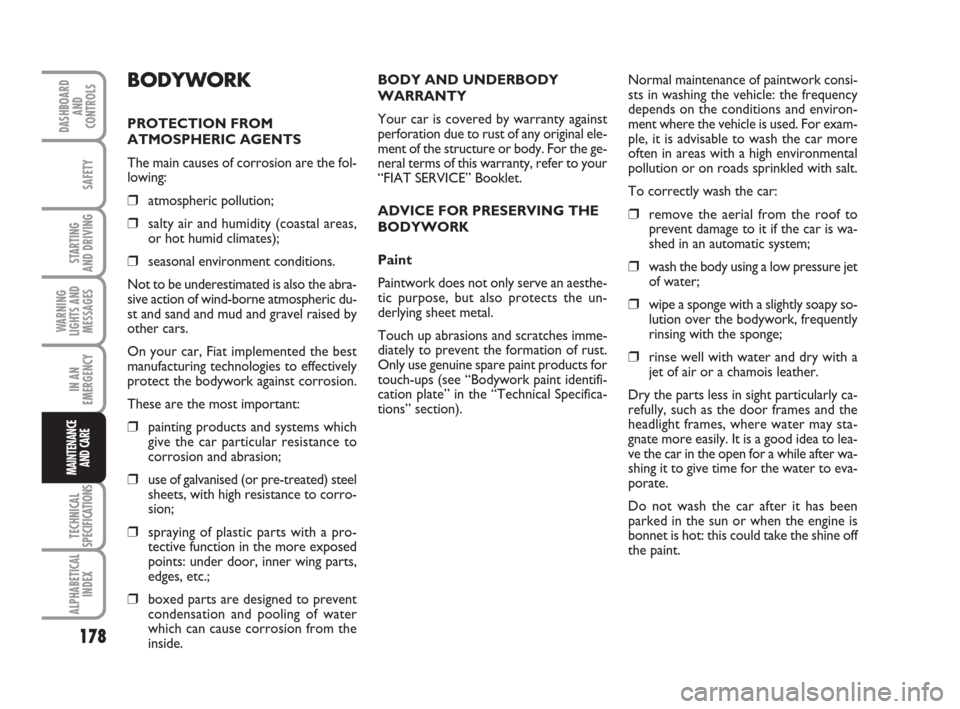
178
STARTING
AND DRIVING
IN AN
EMERGENCY
TECHNICAL
SPECIFICATIONS
ALPHABETICAL
INDEX
DASHBOARD
AND
CONTROLS
SAFETY
WARNING
LIGHTS AND
MESSAGES
MAINTENANCE
AND CARE
BODYWORK
PROTECTION FROM
ATMOSPHERIC AGENTS
The main causes of corrosion are the fol-
lowing:
❒atmospheric pollution;
❒salty air and humidity (coastal areas,
or hot humid climates);
❒seasonal environment conditions.
Not to be underestimated is also the abra-
sive action of wind-borne atmospheric du-
st and sand and mud and gravel raised by
other cars.
On your car, Fiat implemented the best
manufacturing technologies to effectively
protect the bodywork against corrosion.
These are the most important:
❒painting products and systems which
give the car particular resistance to
corrosion and abrasion;
❒use of galvanised (or pre-treated) steel
sheets, with high resistance to corro-
sion;
❒spraying of plastic parts with a pro-
tective function in the more exposed
points: under door, inner wing parts,
edges, etc.;
❒boxed parts are designed to prevent
condensation and pooling of water
which can cause corrosion from the
inside.BODY AND UNDERBODY
WARRANTY
Your car is covered by warranty against
perforation due to rust of any original ele-
ment of the structure or body. For the ge-
neral terms of this warranty, refer to your
“FIAT SERVICE” Booklet.
ADVICE FOR PRESERVING THE
BODYWORK
Paint
Paintwork does not only serve an aesthe-
tic purpose, but also protects the un-
derlying sheet metal.
Touch up abrasions and scratches imme-
diately to prevent the formation of rust.
Only use genuine spare paint products for
touch-ups (see “Bodywork paint identifi-
cation plate” in the “Technical Specifica-
tions” section).Normal maintenance of paintwork consi-
sts in washing the vehicle: the frequency
depends on the conditions and environ-
ment where the vehicle is used. For exam-
ple, it is advisable to wash the car more
often in areas with a high environmental
pollution or on roads sprinkled with salt.
To correctly wash the car:
❒remove the aerial from the roof to
prevent damage to it if the car is wa-
shed in an automatic system;
❒wash the body using a low pressure jet
of water;
❒wipe a sponge with a slightly soapy so-
lution over the bodywork, frequently
rinsing with the sponge;
❒rinse well with water and dry with a
jet of air or a chamois leather.
Dry the parts less in sight particularly ca-
refully, such as the door frames and the
headlight frames, where water may sta-
gnate more easily. It is a good idea to lea-
ve the car in the open for a while after wa-
shing it to give time for the water to eva-
porate.
Do not wash the car after it has been
parked in the sun or when the engine is
bonnet is hot: this could take the shine off
the paint.
Page 180 of 210
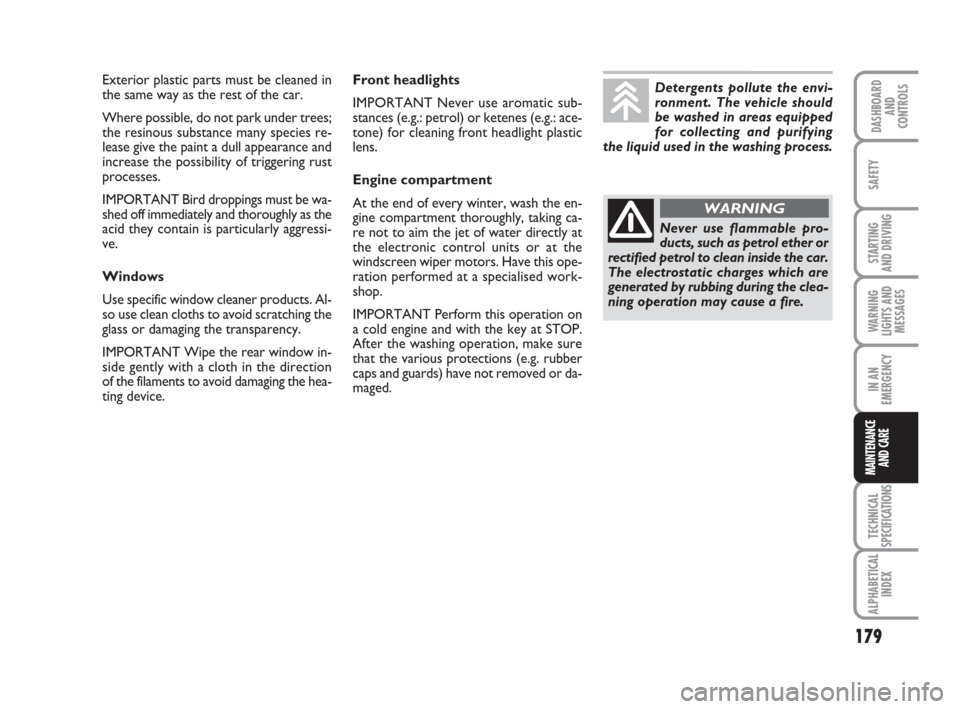
179
STARTING
AND DRIVING
IN AN
EMERGENCY
TECHNICAL
SPECIFICATIONS
ALPHABETICAL
INDEX
DASHBOARD
AND
CONTROLS
SAFETY
WARNING
LIGHTS AND
MESSAGES
MAINTENANCE
AND CARE
Exterior plastic parts must be cleaned in
the same way as the rest of the car.
Where possible, do not park under trees;
the resinous substance many species re-
lease give the paint a dull appearance and
increase the possibility of triggering rust
processes.
IMPORTANT Bird droppings must be wa-
shed off immediately and thoroughly as the
acid they contain is particularly aggressi-
ve.
Windows
Use specific window cleaner products. Al-
so use clean cloths to avoid scratching the
glass or damaging the transparency.
IMPORTANT Wipe the rear window in-
side gently with a cloth in the direction
of the filaments to avoid damaging the hea-
ting device.Front headlights
IMPORTANT Never use aromatic sub-
stances (e.g.: petrol) or ketenes (e.g.: ace-
tone) for cleaning front headlight plastic
lens.
Engine compartment
At the end of every winter, wash the en-
gine compartment thoroughly, taking ca-
re not to aim the jet of water directly at
the electronic control units or at the
windscreen wiper motors. Have this ope-
ration performed at a specialised work-
shop.
IMPORTANT Perform this operation on
a cold engine and with the key at STOP.
After the washing operation, make sure
that the various protections (e.g. rubber
caps and guards) have not removed or da-
maged.Detergents pollute the envi-
ronment. The vehicle should
be washed in areas equipped
for collecting and purifying
the liquid used in the washing process.
Never use flammable pro-
ducts, such as petrol ether or
rectified petrol to clean inside the car.
The electrostatic charges which are
generated by rubbing during the clea-
ning operation may cause a fire.
WARNING
Page 181 of 210
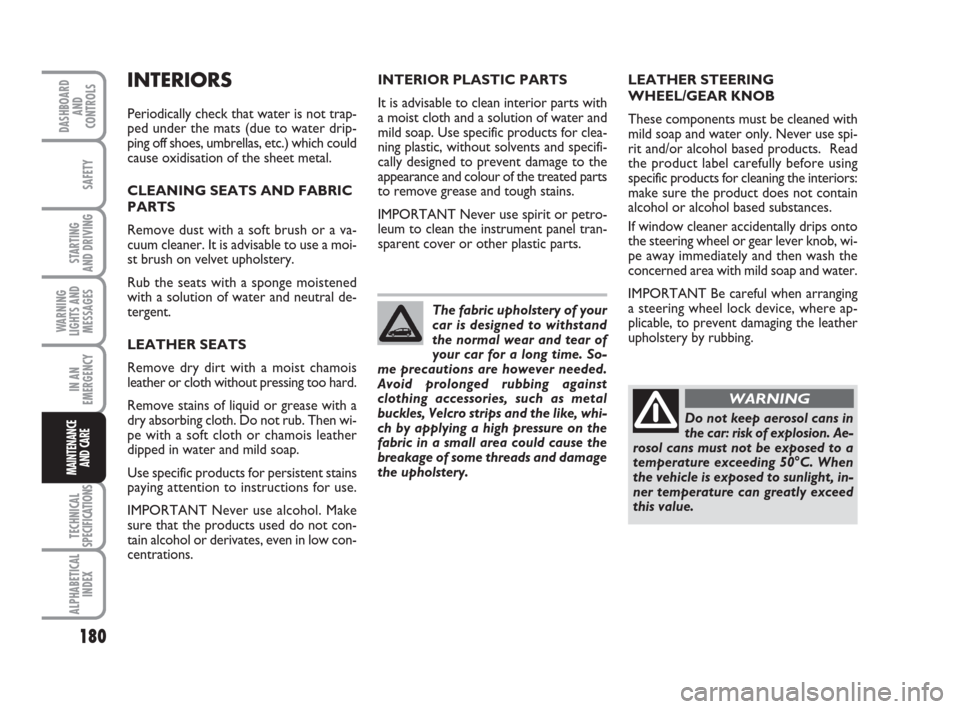
180
STARTING
AND DRIVING
IN AN
EMERGENCY
TECHNICAL
SPECIFICATIONS
ALPHABETICAL
INDEX
DASHBOARD
AND
CONTROLS
SAFETY
WARNING
LIGHTS AND
MESSAGES
MAINTENANCE
AND CARE
INTERIORS
Periodically check that water is not trap-
ped under the mats (due to water drip-
ping off shoes, umbrellas, etc.) which could
cause oxidisation of the sheet metal.
CLEANING SEATS AND FABRIC
PARTS
Remove dust with a soft brush or a va-
cuum cleaner. It is advisable to use a moi-
st brush on velvet upholstery.
Rub the seats with a sponge moistened
with a solution of water and neutral de-
tergent.
LEATHER SEATS
Remove dry dirt with a moist chamois
leather or cloth without pressing too hard.
Remove stains of liquid or grease with a
dry absorbing cloth. Do not rub. Then wi-
pe with a soft cloth or chamois leather
dipped in water and mild soap.
Use specific products for persistent stains
paying attention to instructions for use.
IMPORTANT Never use alcohol. Make
sure that the products used do not con-
tain alcohol or derivates, even in low con-
centrations. INTERIOR PLASTIC PARTS
It is advisable to clean interior parts with
a moist cloth and a solution of water and
mild soap. Use specific products for clea-
ning plastic, without solvents and specifi-
cally designed to prevent damage to the
appearance and colour of the treated parts
to remove grease and tough stains.
IMPORTANT Never use spirit or petro-
leum to clean the instrument panel tran-
sparent cover or other plastic parts.
Do not keep aerosol cans in
the car: risk of explosion. Ae-
rosol cans must not be exposed to a
temperature exceeding 50°C. When
the vehicle is exposed to sunlight, in-
ner temperature can greatly exceed
this value.
WARNING
The fabric upholstery of your
car is designed to withstand
the normal wear and tear of
your car for a long time. So-
me precautions are however needed.
Avoid prolonged rubbing against
clothing accessories, such as metal
buckles, Velcro strips and the like, whi-
ch by applying a high pressure on the
fabric in a small area could cause the
breakage of some threads and damage
the upholstery.
LEATHER STEERING
WHEEL/GEAR KNOB
These components must be cleaned with
mild soap and water only. Never use spi-
rit and/or alcohol based products. Read
the product label carefully before using
specific products for cleaning the interiors:
make sure the product does not contain
alcohol or alcohol based substances.
If window cleaner accidentally drips onto
the steering wheel or gear lever knob, wi-
pe away immediately and then wash the
concerned area with mild soap and water.
IMPORTANT Be careful when arranging
a steering wheel lock device, where ap-
plicable, to prevent damaging the leather
upholstery by rubbing.
Page 182 of 210
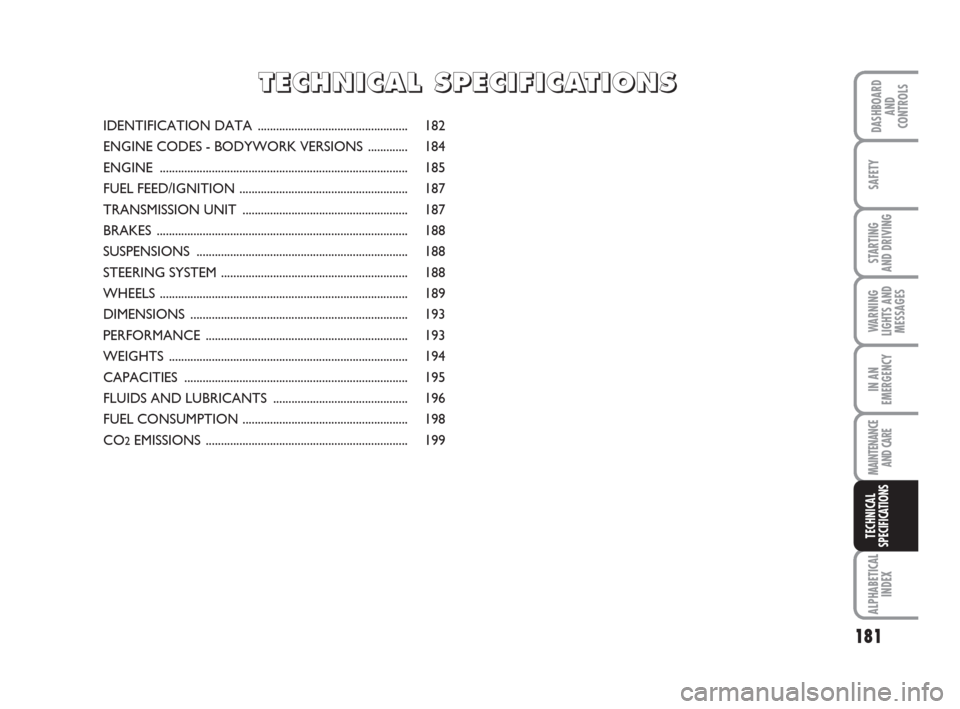
181
STARTING
AND DRIVING
IN AN
EMERGENCY
MAINTENANCE
AND CARE
ALPHABETICAL
INDEX
DASHBOARD
AND
CONTROLS
SAFETY
WARNING
LIGHTS AND
MESSAGES
TECHNICAL
SPECIFICATIONS
IDENTIFICATION DATA ................................................. 182
ENGINE CODES - BODYWORK VERSIONS ............. 184
ENGINE ................................................................................. 185
FUEL FEED/IGNITION ....................................................... 187
TRANSMISSION UNIT ...................................................... 187
BRAKES .................................................................................. 188
SUSPENSIONS ..................................................................... 188
STEERING SYSTEM ............................................................. 188
WHEELS ................................................................................. 189
DIMENSIONS ....................................................................... 193
PERFORMANCE .................................................................. 193
WEIGHTS .............................................................................. 194
CAPACITIES ......................................................................... 195
FLUIDS AND LUBRICANTS ............................................ 196
FUEL CONSUMPTION ...................................................... 198
CO
2EMISSIONS .................................................................. 199
T T
E E
C C
H H
N N
I I
C C
A A
L L
S S
P P
E E
C C
I I
F F
I I
C C
A A
T T
I I
O O
N N
S S
Page 183 of 210

182
STARTING
AND DRIVING
MAINTENANCE
AND CARE
ALPHABETICAL
INDEX
DASHBOARD
AND
CONTROLS
SAFETY
WARNING
LIGHTS AND
MESSAGES
TECHNICAL
SPECIFICATIONS
IDENTIFICATION DATA
We recommend taking note of the iden-
tification codes. The identification data are
printed on labels fig. 1in the following po-
sitions:
1- Model plate
2- Chassis marking.
3- Bodywork paint identification plate.
4- Engine marking.
MODEL PLATE
fig. 2
This plate is fitted to the engine compart-
ment front crossmember and contains the
following data:
B- Type-approval number.
C- Vehicle type code.
D- Chassis number.
E- Maximum vehicle weight fully loaded.F- Maximum vehicle weight fully loaded
with trailer.
G- Maximum vehicle weight on front ax-
le.
H- Maximum vehicle weight on rear ax-
le.
I- Engine Type
L- Bodywork version code.
M- Spare part code.
N- Smoke opacity index (for diesel en-
gines).
fig. 1
4
21
3
F0H0225mfig. 2F0H0760m
IN AN
EMERGENCY
Page 184 of 210
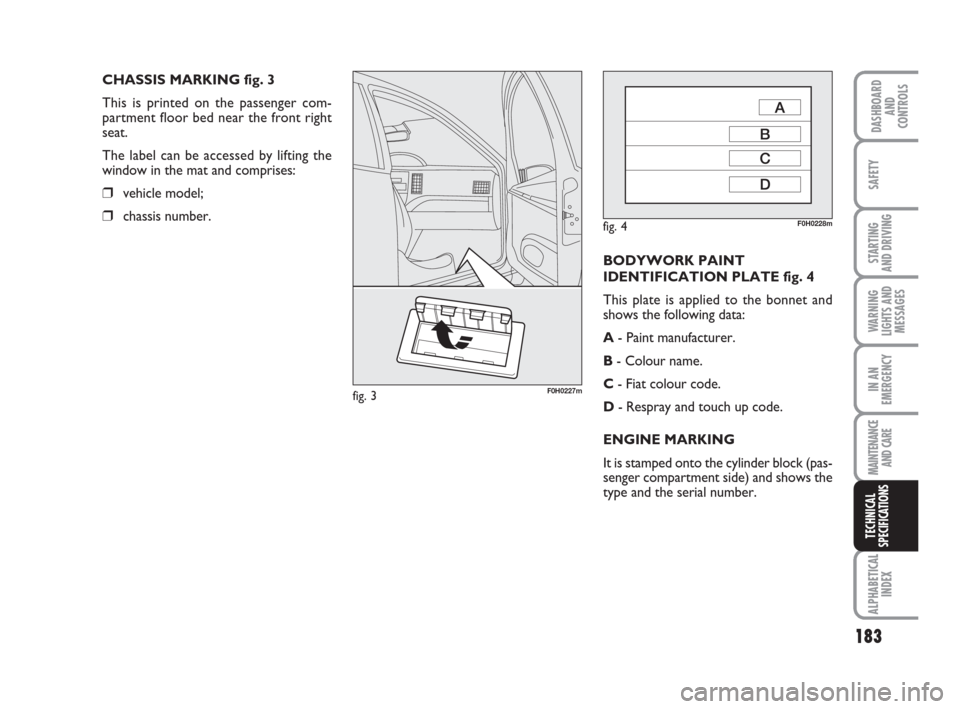
183
STARTING
AND DRIVING
IN AN
EMERGENCY
MAINTENANCE
AND CARE
ALPHABETICAL
INDEX
DASHBOARD
AND
CONTROLS
SAFETY
WARNING
LIGHTS AND
MESSAGES
TECHNICAL
SPECIFICATIONS
CHASSIS MARKING fig. 3
This is printed on the passenger com-
partment floor bed near the front right
seat.
The label can be accessed by lifting the
window in the mat and comprises:
❒vehicle model;
❒chassis number.
fig. 3F0H0227m
fig. 4F0H0228m
BODYWORK PAINT
IDENTIFICATION PLATE fig. 4
This plate is applied to the bonnet and
shows the following data:
A- Paint manufacturer.
B- Colour name.
C- Fiat colour code.
D- Respray and touch up code.
ENGINE MARKING
It is stamped onto the cylinder block (pas-
senger compartment side) and shows the
type and the serial number.